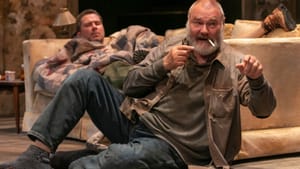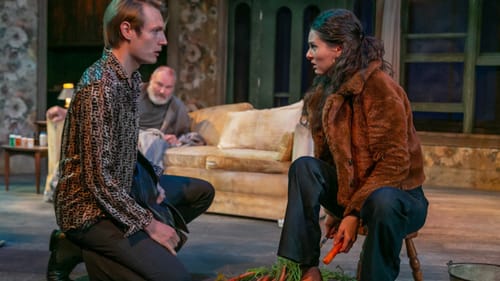Stay in the Loop
BSR publishes on a weekly schedule, with an email newsletter every Wednesday and Thursday morning. There’s no paywall, and subscribing is always free.
Home is where the hurt is
Shakespeare Theatre of New Jersey presents Sam Shepard's 'Buried Child'

Shakespeare Theatre of New Jersey steps outside its comfort zone with Buried Child, Sam Shepard’s dark deconstruction of the myth of the American family. The company deserves admiration for taking a risk with this still-shocking 1979 play, but director Paul Mullins’s inconsistently acted, oddly paced production mostly misses the mark.
The Pulitzer Prize-winning center of Shepard’s “Family Trilogy” (along with Curse of the Starving Class and True West), Buried Child gives violent life to the old adage that you can’t go home again. Michael Schweikardt’s dilapidated set, a once-respectable farmhouse gone to seed, serves as the stage for ancestral recriminations, hidden angst, and a wellspring of domestic disappointment. The fertile ground of Shepard country sprouts forth sad secrets and barely hidden disgust.
All in the timing
Dodge (Sherman Howard), the patriarch, spends most of the play on the couch — smoking, drinking, and waiting for death. His hectoring wife Halie (Carol Halstead) maintains an outward appearance of respectability while surreptitiously screwing the town minister. Their two grown sons, Tilden (Anthony Marble) and Bradley (Roger Clark), have both returned to the homestead, each acting like a lord of misrule in his own way.
Into this strange scenario comes Vince (Paul Cooper), Tilden’s long-lost son, a nattily dressed musician whom no one seems to recognize. He brings along Shelly (Andrea Morales), a young woman who captivates and titillates the menfolk. Across a breathless 24 hours, the outlandish nuclear family detonates an atomic bomb’s worth of pain and suffering on one another, ramping up their casual cruelty to a fever pitch.
A wry chronicler of middle-class American life, Shepard draws from a variety of archetypes to construct his most untypical brood. He riffs on the quaintness of 1950s sitcoms, midcentury kitchen-sink dramas, and other entertainments that lovingly venerate the quaint, wholesome values of a bygone era. He suggests that a deep-rooted rot was always at the core of this carefully constructed ethos.
But a successful production of Buried Child requires an overarching sense of unease. Even as the audience laughs, they should feel a chill in their bones for the terror that might lurk around the bend. Mullins never achieves this effect. A too-facile take on the comedic elements dominates here, while the subtext barely gets a scratch.

Any sense of rising tension is zapped by two mood-killing intermissions which, although they mark Shepard’s written act breaks, serve here only to disrupt the play’s flow. With a running time of barely two hours, they’re unnecessary.
No devil in the details
As the interlopers, Cooper and Morales inject the proceedings with an appropriate sense of foreboding. Both begin their performances tentatively, but by the wild third act, they fully achieve the elliptical, jazzlike rhythm of Shepard’s dialogue.
Cooper especially does well by Vince’s haunting, dreamlike final monologue, and Morales brings a level of vivacious confidence to Shelly that I’ve rarely seen. More than ever, she seems a Yankee cousin to Ruth, the seductive intruder in Harold Pinter’s The Homecoming. She also strangely suggests J.M. Barrie’s Wendy, a character poised uncomfortably between mother/sister figure and gamine object of desire.
Howard seems too hale and hearty for a man who claims he’s “barely got the strength to breathe.” His tubercular hacks sound stagy, and he executes his upward lunges from the couch with practiced ease.
Halstead’s Halie plays too hard for laughs, a prairie Cruella de Vil in a too-elegant black suit (costumes by Andrea Hood). Neither Marble nor Clark communicates the menacing energy of their characters, failures of manhood borne back into the nest. Michael Dale wrings a few laughs from the small role of Halie’s preacher paramour, but he overstates the character’s drunken loucheness.
Near the end of Buried Child, Halie gives voice to the roiling underbelly of American life: “You can’t leave the house for one second without the devil blowing through the front door.” In this production, for better or worse, Lucifer mostly stays at bay.
What, When, Where
Buried Child. By Sam Shepard, Paul Mullins directed. Through October 7, 2018, at the Shakespeare Theatre of New Jersey, 36 Madison Avenue, Madison, New Jersey. (973) 408-5600 or shakespearenj.org.
Sign up for our newsletter
All of the week's new articles, all in one place. Sign up for the free weekly BSR newsletters, and don't miss a conversation.

 Cameron Kelsall
Cameron Kelsall